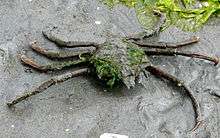Epialtinae
Epialtinae is a subfamily of crabs, containing the following genera:[1]
- Acanthonyx Latreille, 1828
- Alcockia Števčić, 2005
- Antilibinia MacLeay, 1838
- Cyclonyx Miers, 1879
- Epialtoides Garth, 1958
- Epialtus H. Milne-Edwards, 1834
- Esopus A. Milne-Edwards, 1875
- Eupleurodon Stimpson, 1871
- Goniothorax A. Milne-Edwards, 1878
- Griffinia Richer de Forges, 1994
- Huenia De Haan, 1837
- Leucippa H. Milne-Edwards, 1833
- Lophorochinia Garth, 1969
- Menaethiops Alcock, 1895
- Menaethius A. Milne-Edwards, 1834
- Mimulus Stimpson, 1860
- Mocosa Stimpson, 1871
- Perinia Dana, 1851
- Pugettia Dana, 1851
- Sargassocarcinus Ward, 1936
- Simocarcinus Miers, 1879
- Taliepus A. Milne-Edwards, 1878
- Xenocarcinus White, 1847
| Epialtinae | |
|---|---|
 | |
| Pugettia producta (Northern kelp crab), with first pereiopods missing | |
| Scientific classification | |
| Kingdom: | Animalia |
| Phylum: | Arthropoda |
| Subphylum: | Crustacea |
| Class: | Malacostraca |
| Order: | Decapoda |
| Infraorder: | Brachyura |
| Family: | Epialtidae |
| Subfamily: | Epialtinae MacLeay, 1838 |
| Genera | |
|
See text | |
Incertae sedis
- Acanthonyx elongatus White, 1847 (nomen nudum)
- Huenia dehaanii White, 1848
- Huenia proteus var. tenuipes Adams & White, 1848
- Inachus australis Gray, 1831
- Menaethius brevirostris Heller, 1862
gollark: It is merely a tessellation of heptagons and hexagons in the Poincare disk model of hyperbolic geometry.
gollark: It isn't, as mentioned there.
gollark: Oh, they did.
gollark: The irony is that the copypastas advertise pizza *far* more than me.
gollark: Looks like a webhook.
References
- Peter K. L. Ng, Danièle Guinot & Peter J. F. Davie (2008). "Systema Brachyurorum: Part I. An annotated checklist of extant Brachyuran crabs of the world" (PDF). Raffles Bulletin of Zoology. 17: 1–286. Archived from the original (PDF) on 2011-06-06.
This article is issued from Wikipedia. The text is licensed under Creative Commons - Attribution - Sharealike. Additional terms may apply for the media files.